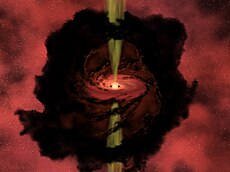L1014
| Dark nebula | |
|---|---|
 L1014 (artistic image) | |
| Observation data: J2000 epoch | |
| Subtype | |
| Class | 6[1] |
| Right ascension | 21h 24m 06s |
| Declination | +49° 59′ 07″ |
| Distance | 200[1] pc |
| Apparent diameter | ~2′[2] |
| Constellation | Cygnus |
| Designations | 1014. |
L1014 is a dark nebula in the Cygnus constellation. It may be among the most centrally condensed small dark clouds known, perhaps indicative of the earliest stages of star formation processes. This cloud harbors at its core a very young low-mass star named ; some astronomers have suggested that this object may be a brown dwarf or even a rogue planet at the earliest stage of its lifetime.[3]
References[]
- ^ a b Young, C. H.; Jorgensen, J. K.; Shirley, Y. L.; Kauffmann, J.; Huard, T.; Lai, S. P.; Lee, C. W.; Crapsi, A.; Bourke, T. L.; Dullemond, C. P.; Brooke, T. Y.; Porras, A.; Spiesman, W.; Allen, L. E.; Blake, G. A.; Evans Ii, N. J.; Harvey, P. M.; Koerner, D. W.; Mundy, L. G.; Myers, P. C.; Padgett, D. L.; Sargent, A. I.; Stapelfeldt, K. R.; Van Dishoeck, E. F.; Bertoldi, F.; Chapman, N.; Cieza, L.; Devries, C. H.; Ridge, N. A.; Wahhaj, Z. (2004). "A "Starless" Core that Isn't: Detection of a Source in the L1014 Dense Core with the Spitzer Space Telescope". The Astrophysical Journal Supplement Series. 154: 396. arXiv:astro-ph/0406371. Bibcode:2004ApJS..154..396Y. doi:10.1086/422818.
- ^ Dutra, C. M.; Bica, E. (2002). "A catalogue of dust clouds in the Galaxy". Astronomy and Astrophysics. 383 (2): 631. arXiv:astro-ph/0203256. Bibcode:2002A&A...383..631D. doi:10.1051/0004-6361:20011761.
- ^ Bourke, Tyler L.; Crapsi, Antonio; Myers, Philip C.; et al. (2005). "Discovery of a Low-Mass Bipolar Molecular Outflow from L1014-IRS with the Submillimeter Array". The Astrophysical Journal. 633 (2): L129. arXiv:astro-ph/0509865. Bibcode:2005ApJ...633L.129B. doi:10.1086/498449.
External links[]
- The Starless Core That Isn't // Spitzer Image, Release Date: 11/09/04
- Spitzer Sees Ice and Warm Glows in Dark and Dusty Places // NASA 11.09.04
Categories:
- Cygnus (constellation)
- Dark nebulae
- Nebula stubs